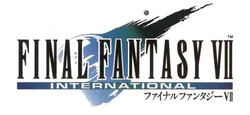Template:Sideicon
The International Version (インターナショナル版, Intānashonaru Han?) is a recurring Japan-only edition of several games in the Final Fantasy series. These versions reflect the changes made in the international adaptations of the games' original versions, including the new story elements and gameplay changes.
More recent International versions include completely new features in the games with optional tweaks in gameplay, new superbosses, and bonus dungeons; in addition, the audio is in English, with Japanese text and subtitles. They often come with extra information like design art, interviews with the creators, maps, and other features.
Appearances
Final Fantasy VII International
The International versionis a direct port of the North American version, including all of its gameplay and storyline tweaks. It came with an extra fourth disc that includes bonus background information about the game itself.
Dirge of Cerberus -Final Fantasy VII- International
The International version is a direct port of the North American and European versions, retaining all the gameplay changes that were made for international release.
Final Fantasy X: International
The International edition includes new Sphere Grids, new bosses such as the Dark Aeons, and a bonus disc filled with special features. The International version is the only version of Final Fantasy X that was released in Europe and for that reason was not tagged with the "International Edition" tag.
The game was remastered in HD and included in Final Fantasy X|X-2 HD Remaster which was released in Japan on December 26th, 2013, in North America on March 18th, 2014, and in the PAL region on March 21st, 2014, marking its first time appearance in North America.
Final Fantasy X-2: International + Last Mission
Initially, the International version was never released outside of Japan. Along with the gameplay tweaks allowing for use of additional characters and modes, this version includes an extra postscript called Final Fantasy X-2: Last Mission which contains cutscenes that depend on the story completion the player achieved for Final Fantasy X-2.
The game was remastered in HD and included in Final Fantasy X|X-2 HD Remaster which was released in Japan on December 26th, 2013, in North America on March 18th, 2014, and in the PAL region on March 21st, 2014, marking its first time appearance outside of Japan.
Final Fantasy XII International Zodiac Job System
Massive changes to Final Fantasy XII were made to its International version, some so great that the gameplay is almost completely different. It includes the Zodiac Job System, a completely new variation on the battle system. It also includes a special bonus gameplay mode called Trial Mode and a New Game Plus feature. A remastered version of Final Fantasy XII, Final Fantasy XII The Zodiac Age, was release in all major markets for PlayStation 4, Xbox One, Nintendo Switch and Steam, and is based on the International version.
Final Fantasy XIII Ultimate Hits International
The Ultimate Hits International version was released for Xbox 360 in Japan on December 16th, 2010. This version includes English audio with Japanese, North American and European subtitles for player to choose from. A new difficulty option, Easy Mode, is added with increased enemy stagger susceptibility and Item drop rate. The preorder bonus booklet Final Fantasy XIII -Corridor of Memory- features high resolution promotional artwork, unreleased story scripts and stages, and a novel explaining the events after the epilogue.
Dissidia Final Fantasy: Universal Tuning
Square Enix released a direct port of the North American version in Japan on November 1, 2009.[1] It retains all of the modifications and additional content implemented in the North American version, including the new Arcade Mode and the battle rebalanced.
Bravely Default: For the Sequel
Bravely Default: For the Sequel is an enhanced re-release of the original Bravely Default: Flying Fairy, featuring many updates and differences to the original game, most notably the inclusion of an updated version of the battle system that would go on to be used in Bravely Second: End Layer. This version would become the base for the international versions of Bravely Default.
- List of Changes
- Multiple save files.
- Additional difficulty levels.
- The game now autosaves when entering a new area.
- Various graphical touch-ups.
- Party Chats now feature animated 3D models instead of static 2D images.
- The ability to disable the gaining of EXP, pg, and JP as well as changing the encounter rate from the main menu.
- The Bravely Second mechanic is introduced, allowing players to stop time at any point mid-battle and make commands at the cost of newly-added SP.
- SP is now gained while the system is closed and the game is left on, up to a maximum of 3.
- During Bravely Second, the damage cap is able to be broken.
- Subtitles in Japanese, English, French, Spanish, German and Italian.
- Voiceovers in Japanese and English.
- Inclusion of an Event Viewer in D's Journal.
- Monsters can now invade the village during the Norende Reconstruction minigame, and can also be battled.
- Many classes were rebalanced.
- Costumes are no longer regarded as a piece of armor, and are instead their own, separate equipment type.
- New cutscenes in later chapters.
- Connectivity with the Japanese Square Enix Members site to unlock in-game items and costumes.

